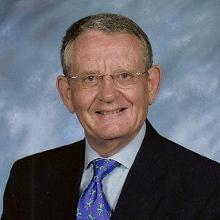How Quantum Mechanics Helps Us Breathe

Antonio Guillem via shutterstock
(Inside Science) – Why don't we suffocate whenever we try to take a breath? An international team of scientists has used quantum mechanics – the science that usually deals with events at the level of the ultra-small – to solve this human-sized mystery.
Quantum mechanics has long proved its value in understanding such phenomena as the behavior of electrons and in classifying subatomic particles. But in recent years theorists have increasingly shown how it applies to all facets of life, large and small.
The new research, led by Cédric Weber of Kings College, London and reported in the journal Proceedings of the National Academy of Sciences, confirms that point.
"This work," said team member David O'Regan, a physicist at Ireland's Trinity College, Dublin, "helps to illustrate the fact that quantum-mechanical effects, which may sometimes be viewed as somehow very exotic or only relevant under extreme conditions, are at play in the day-to-day regimes where biology, chemistry, and materials science operate."
The conundrum elucidated by Weber's team stems from the way in which carbon monoxide reacts with proteins that carry oxygen around our bodies.
Those proteins, which contain iron atoms, transport oxygen molecules through the bloodstream to wherever the body needs them. According to conventional theory, the proteins should typically link up more often with molecules of carbon monoxide – from inside and outside the body – than with oxygen molecules.
If that happened regularly, it would result in asphyxiation, killing off humans and animals.
The small amounts of carbon monoxide naturally produced in our bodies would not be enough to displace oxygen fully, even if it had a greater binding ability. But we would be more vulnerable to poisoning by carbon monoxide in the atmosphere than experience shows to be the case. The fact that this doesn't happen means that oxygen molecules bind more effectively to proteins than theory forecasts.
"The problem that scientists have had is explaining how the proteins achieve this discrimination in favor of oxygen," said team member Daniel Cole, a chemist at Yale University in New Haven, Connecticut.
To do so, the team applied a computer simulation technique based on quantum mechanics to reactions of oxygen and carbon monoxide with myoglobin, the main oxygen-carrying protein in muscle tissue.
The technique, called density-functional theory, or DFT, won the 1998 Nobel Prize in Chemistry for its progenitor, Walter Kohn of the University of California, Santa Barbara. Since then it has become a bulwark of theoretical chemistry and physics.
"DFT has been the standard tool for simulating electronic properties of materials and molecules for a number of years," O'Regan said.
The team used the technique to study reactions between the iron atom inside myoglobin and a molecule of oxygen or carbon monoxide. These reactions involve electrostatics, the arrangement of electric charges in atoms and molecules. When the iron atom transfers negative electric charges to an oxygen or carbon monoxide molecule, it enables the molecule to attach itself to the entire myoglobin protein.
Unfortunately, the theory consistently predicted that carbon monoxide should bind to myoglobin much more readily than oxygen.
"Our previous DFT calculations had shown that there is a transfer of about half an electron to the oxygen molecule," Cole noted. "Although this provided some stabilization, it was not enough; the calculations predicted that carbon monoxide should be much, much more strongly bound than oxygen."
In response, the team employed two fresh approaches to the problem.
Because myoglobin molecules contain more than 1,000 atoms, the scientists used a special variety of DFT that, according to O'Regan, "is designed for dealing with larger systems without compromising on accuracy."
They also applied another extension of DFT, called dynamical mean-field theory.
"Using DMFT, we showed that, in fact, close to one electron is transferred to the oxygen molecule," Cole explained. "This provides much greater electrostatic stabilization than previously thought. It means that our estimate of the relative binding of oxygen and carbon dioxide is now in excellent agreement with experiment."
The analysis revealed that an effect called entanglement plays a critical role in binding oxygen molecules to the protein. Entanglement is a quintessential characteristic of quantum mechanics that links pairs of electrons so strongly that they no longer act independently. The process also involves Hund's exchange, another quantum-mechanical property that previous simulations had ignored.
"These effects strengthen the direct bonding between iron and oxygen, and also enhance electrostatic interactions with the protein," Cole explained.
The overall result: "We significantly improve the agreement of theory with experiment in terms of the relative tendencies to bind oxygen and carbon monoxide," O'Regan said.
The research has potential uses beyond understanding the molecular basis of breathing. According to Cole, the better understanding of how molecules bind to iron-containing proteins could help the drug-development process and possibly facilitate the design of artificial photosynthesis devices that would capture and store energy from the sun.

